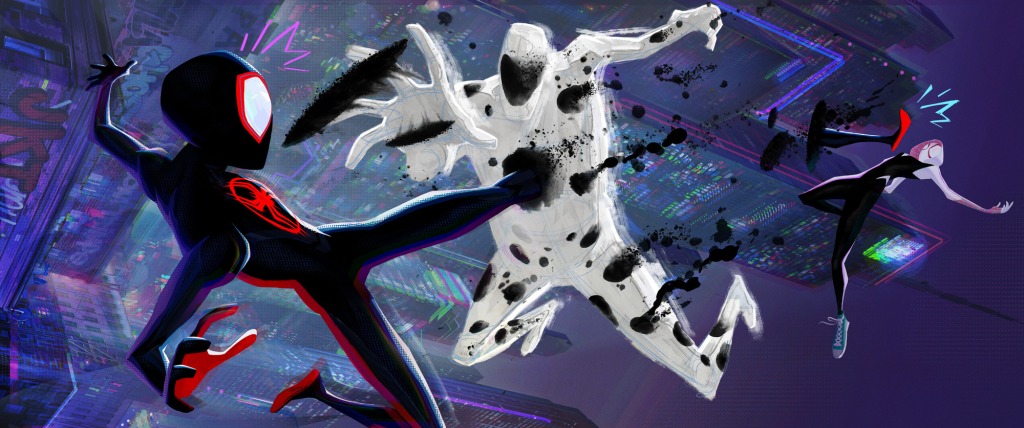[ad_1]
The Brooklyn Spider-Man travels miles across verses. It’s frenetic, visually spectacular, but doesn’t quite cast its web like the preceding film in 2018. Hailee Steinfeld though steals the show.
Rating: ⭐️⭐️🌟 (2.5 / 5)

By Mayur Lookhar
Many would agree that Spider-Man: Into the Spider-Verse [2018] is perhaps the finest Spider-Man movie. It turned the Spider-Man legacy on its head by introducing the first ever African-American Spider-Man. The visual imagery, brilliant voice cast combined to give a unique experience.
Near five years later, comes the sequel, Spider-Man: Across the Spider-Verse. Phil Lord is the lone writer from the first film to travel Across the Spider-Verse. Christopher Miller, Lord’s co-writer of The Lego Movie [2014], and David Callaham have joined hands with Lord for Spider-Man: Across the Spider-Verse [2023]. The sequel has a new set of directors in Joaquim Dos Santos, Kemp Powers, and Justin K. Thompson. Into The Spider-Verse was all about the beginning, how a humble Black Hispanic boy from Brooklyn ends up becoming a Spider-Man.
The second film was expected to be an extension of the journey. Phil Lord, Miller and Callaham make Miles Morales [Shameik Moore] travel across verses, and in the process bump into many Spider-Men/Women. The film though begins with a prelude to Gwen Stacy [Hailee Steinfeld], the Spider-Woman in white. In her world, Stacy had to endure the pain of seeing a young Peter Parker die in her arms. Unfortunately, her cop father presumed that the Spider-Woman killed his young friend Peter Parker. He Is unaware that the masked Spider-lady is his daughter. That episode has since left a gulf in the father-daughter relationship.
Meanwhile, Morales, too, is facing adolescent issues as he struggles to balance his vigilante and personal life. The bunked-classes, lower grades see the school principal haul up his parents. Miles does show up late but leaves equally fast as he has a weird, funny villain to take care of. The family drama has a soap-opera feeling.
Miles is bemused by this Dalmatian-looking like villain who was out to steal an ATM machine. Is he a villain though? The faceless man is all white with black spots around his body. He regrets stealing the ATM machine. While they fight, The Spot, as he calls himself, tells his sob story how his disfigured face, body has seen him out of job. The Spot blames Miles for his condition. He likens himself as Spider-Man’s greatest nemesis. But to Morales, The Spot is a joke of a villain. At the critical moment in the battle, The Spot [Jason Schwartzman] kicks his own butt. Soon, he learns that he is much more powerful as the spots on his body are portals that he can explore at wish.
The second round of Spider-Man versus The Spot battle takes places in 2033 far away in a futuristic Mumbattan city, a pseudonym for Mumbai, India. It’s here that Miles also meets with the Indian Spider-Man Pavitr Prabhakar [Karan Soni]. Before landing in Mumbattan, Miles had bumped into Miguel O’Hara [Oscar Issac] aka Vampire Spider-Man 2099, Jessica Drew [Issa Rae] – the pregnant Spider-Woman – in Brooklyn. The duo entered Miles’ Brooklyn to tame the Vulture who needed to be put back into his particular Spider-Verse. Ah, portal confusion, Spider-Men/Women, super-villains entering the wrong verse. Didn’t we see something similar in Marvel’s Spider-Man: No Way Home?
If one recalls, if it wasn’t for Jake B. Johnson’s Peter B. Parker crashing Into the Spider-Verse [2018], Miles Morales wouldn’t have ended up being bitten by the radioactive spider.
As widely acclaimed as Spider-Man: Into the Spider-Verse [2018] was, the first Black Hispanic Spider-Man was always going to evoke a debate. Lord, Miller and Callaham build their Across the Spider-Verse on a ‘was-Miles-meant-to-be-Spider-Man?’ narrative. Through the course of his journey across the Spider HQ, Miles is constantly demeaned with the ‘you-don’t-belong-here’ jibe.
Morales ending up as a Spider-Man might be down to dimension default, but hey, there isn’t no way that this kid from Brooklyn is gonna back down. Not from any fair critics, nor from any Spot. The first film was self-discovery, the sequel is all about standing one’s ground.
Miles Morales is a man of self-esteem but do we have a gripping story here? We felt that Dos Santos, Powers and Thompson’s film falls a few miles short vis-à-vis Into the Spider-Verse [2018]. There’s fine visual imagery, multiple Spider-verse but the feeble story fails to cast its web. Across the Spider-Verse has a No Way Home [2021] hangover. The India-connection is naturally exciting for the desis but that verse perhaps stems more from a commercial compulsion than any substantial creative call.
The many multiverses throw up many Spider creations. The late Stan Lee and illustrator Steve Ditko’s original Spider-Man from the comic book drops into Across the Spider-Verse. That’s a fan moment for the oldies, including yours truly. Among the new creations, there’s Spider-Dino, a Spider-Car, Lego Spider, etc. There’s also a funky, guitar wielding, mohawked Spider-Punk, voiced brilliantly by Daniel Kaluuaya. Jeez, they are so many, charging in a pack that it gets difficult to keep a track of what is rushing onto to your screen.

We read that The Spot wasn’t even the main antagonist in the original idea. It wasn’t until suggested by producer Avi Arad that Lord and Miller decided to have him as the main antagonist. It is befuddling as to how after gaining extreme power, why would it take a near eternity for The Spot to turn up again? What good is a superhero film without a menacing, intimidating super villain? The partly repetitive multi-verse plot felt a drag. This sure could have been trimmed from its exhaustive 140 minutes duration.
Shameik Moore continues from where he left off. The 28-year-old does extremely well to voice for his 15-year-old character. Moore’s tone and the illustration went a long way in building an emotional connect with Miles Morales. It’s another fine voice performance by Moore, and another fine visual arts by the illustrators/animators.
Jake B. Johnson is amusing as the doting father with a little Spidey-tot in his arms for much of this adventure.

The Spider-Men are endearing but it is Gwen Stacy, the teen Spider-Woman who you can’t take your eyes off. Hailee Steinfeld’s voice comes straight from the soul of her animated character. There’s a strong visual-connect to Stacy. The animators have literally brought the character to life with life-like expressions. The Miles-Stacy rendezvous on the Williamsburg Bridge is full of mushiness, and sight to behold. More than Miles, it is Stacy who steals the show.
The animation, music, technical expertise is top notch. Across the Spider-Verse is a visual treat for the Spidey-buffs. The brilliant, immersive visualization in the two films has given a new dimension to the comic culture. These experiences have been better than the live-action representation.
The Miles and Gwen story will be completed when it goes Beyond the Spider-Verse [2024]. Phew, Spidey-maniacs will no doubt cheer the second film. However, for this humble desi reviewer, Across the Spider-Verse fell few miles short of the riveting experience that Into the Spider-Verse offered.
[ad_2]
Source link



![Shiv Thakare-Stan decode Priyanka Chahar Choudhary and Archana Gautam’s fake fight; Netizens agree [View Tweets]](https://webjek.com/wp-content/uploads/2023/02/BB16-600x315.png)










